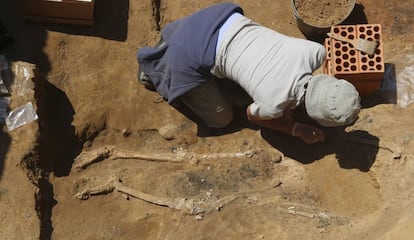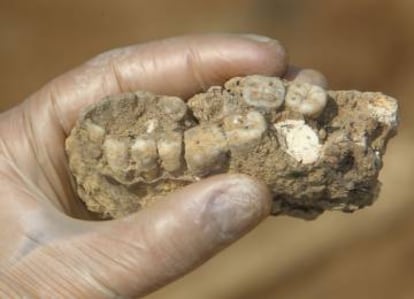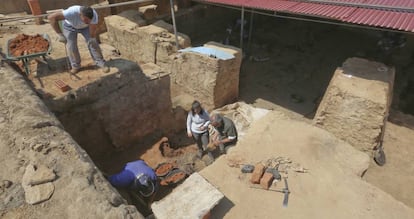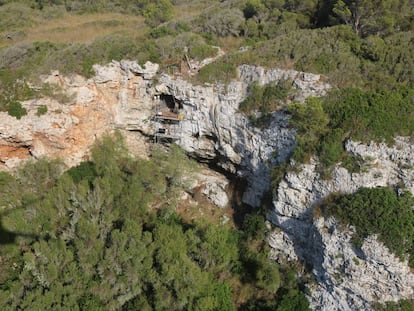Human bones from Tartessos civilization found in Badajoz
A vast two-story 2,500-year-old building in the Turuñuelo de Guareña dig sheds light on the last era of these ancient people


For several thousand years, the final throes of the Tartessos civilization have been shrouded in mystery. But the Turuñuelo de Guareña dig in the Spanish province of Badajoz is shedding new light on this ancient society, which thrived in the southwest of the Iberian Peninsula between the 9th and 5th centuries BCE.
The Tartessos people’s last hurrah appeared to take place in a vast two-story building, which has been frozen in time due to a clay seal. Inside, archaeologists have found a huge number of artifacts as well as animal remains suggesting a ritual involving a banquet and a mass animal sacrifice before they burned the building and buried the remains. But the most significant find to date has been the human bones of what was probably a man around 1.67 meters tall.

A wide passage that circles the building has also been unearthed as well as the feet of a Greek sculpture made of marble, a metamorphic rock that was not thought to have arrived on the peninsula until Roman times.
Victoria Peña, archaeologist and anthropologist at the Complutense University of Madrid, has been working on removing the human bones found on the first floor together with other artifacts such as two bronze braseros (Spanish-style heaters). The legs and skull are well conserved, though the skull has been flattened by the weight of earth and stone that has covered it for so many years.
“The fact the bones were padded and found by a door with a spearhead beside them, makes us think they belonged to a sort of watchman,” says Sebastián Celestino, archaeologist from the Spanish National Research Council (CSIC) and director of the dig along with Esther Rodríguez.

Celestino believes the discovery to be unique as the Tartessos people were generally cremated. As Peña holds the teeth, which show scaling and gum recession, she explains its implications for the team. “It allows us to carry out various studies, including a DNA analysis that will tell us what they ate as well as the origins of him and his ancestors. It will also confirm the gender,” she says.
The sophistication of the artifacts and the size of the building suggest that the Tartessos period was one of great political and economic power. Not only do Greek, Phoenician and Etruscan cups and plates indicate flourishing trade with other Mediterranean cultures, but the discovery of the first marble sculpture on the Iberian peninsula showing the original poly-chrome with the blue of the plinth and the red of the feet and nails suggests a link with the Cyclades Islands – the Greek archipelago in the Aegean Sea.
Architectural jewel
The real jewel of this archaeological crown, however, is the state of preservation of the building itself, which displays extremely advanced architectural techniques. For example, the walls are three meters wide and would have supported a vault with approaching courses, a system in which the bricks would have curved and built up to a point.

So far, researchers have unearthed around 15% of the building, which is thought to have occupied almost a hectare of land. “[Buildings like this] existed in very ancient Mesopotamian cultures but we have never before come across anything like it from this period or in this area,” Celestino explains. “For example, it’s interesting to see the interior buttresses used to support the façade, which must have been pretty big. Besides, the walls are in the floor, making them crosspieces, a very advanced technique to avoid them breaking.”
English version by Heather Galloway.
Tu suscripción se está usando en otro dispositivo
¿Quieres añadir otro usuario a tu suscripción?
Si continúas leyendo en este dispositivo, no se podrá leer en el otro.
FlechaTu suscripción se está usando en otro dispositivo y solo puedes acceder a EL PAÍS desde un dispositivo a la vez.
Si quieres compartir tu cuenta, cambia tu suscripción a la modalidad Premium, así podrás añadir otro usuario. Cada uno accederá con su propia cuenta de email, lo que os permitirá personalizar vuestra experiencia en EL PAÍS.
En el caso de no saber quién está usando tu cuenta, te recomendamos cambiar tu contraseña aquí.
Si decides continuar compartiendo tu cuenta, este mensaje se mostrará en tu dispositivo y en el de la otra persona que está usando tu cuenta de forma indefinida, afectando a tu experiencia de lectura. Puedes consultar aquí los términos y condiciones de la suscripción digital.
More information









































